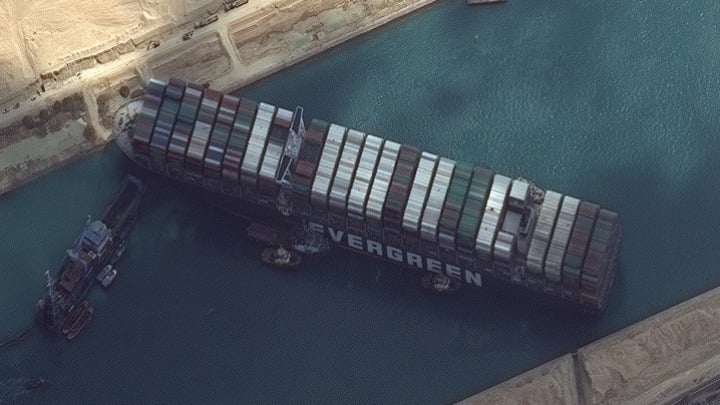
One of the world’s most important shipping lanes, the Suez Canal, thankfully reopened this week after six long days after a container ship, the “Ever Given,” was finally freed from the side of the canal, where it had run aground, after the full moon gave it a boost.
However, as satellite imagery from the National Space and Aeronautic Administration (NASA) shows, the maritime traffic — including 16 Greek-owned vessels — jammed up around both the canal’s north and south ends is substantial and is likely to take some time to disperse.

The ship ran into the side of the canal after it had been forced to sail through a severe wind and sandstorm. Hitting the side of the canal, it became lodged in the hard-packed earth and rocks there. Excavators were employed to try to dig its bulbous bow out of the earth.
Any number of theories were being thought of to try to free the behemoth ship, which is, at 100 yards, as long as an American football field.
Suez Canal’s vital shipping traffic blocked for almost a week
Vital international shipping traffic was completely blocked for six straight days, while some captains turned their vessels around nearly on a dime, realizing they had to do the unthinkable — to sail all the way around Africa, a perilous, 3,100-mile-long journey that will add weeks to their delivery schedules.
Showing just how varied the cargoes can be in all the ships that routinely make their way through the Canal, the vessel directly behind the Ever Given was carrying livestock.
But disaster was averted, thanks to Earth’s satellite the Moon, as it became full on Monday, causing tides to swell enough that the gigantic ship finally floated free.
Engineers who had frantically worked on the problem of excavating enough earth to free the vessel were aided by a natural process — called a high spring tide — in their efforts to dislodge the massive ship, aided by tugboats dredging equipment.

The left image shows typical ship traffic in the Gulf of Suez on February 1, 2021. However, by March 27, the line of waiting ships stretched a full 72 kilometers (45 miles) in back of the unfortunate vessel.
Two days later, ships were backed up as far as 100 kilometers (60 miles) from the entrance to the canal. According to Leth Agencies, 184 vessels were still waiting to get through as of March 30.
Spring tides are surprisingly not reflective of the season the Northern Hemisphere is now experiencing, but rather occur when tides “spring forth” during new and full moons — when the Earth, Sun, and Moon are in alignment, according to the National Ocean Service, part of the National Oceanic and Atmospheric Administration.

On March 29, to the relief of Greek and other shipping companies worldwide, the tides in the Suez Canal rose approximately 46 centimeters (18 inches) above normal. That made it slightly easier to refloat and straighten out the ship.
After being dislodged late in the day on Monday, and after it was determined that the Ever Given had sustained no serious damage in the mishap, the ship continued north into the Great Bitter Lake, a wider part of the Suez Canal system.
Sunday’s full “Worm Moon”
While there are twelve to thirteen full moons in a year, only six to eight are associated with a tide high enough to do what was done on Monday — because the moon is closest to Earth during those full moons, according to CNN meteorologist Judson Jones.
As Jones explains, “It is not uncommon for these tides to be a foot higher than other high tides during the year when the moon is further from the Earth.
“It is no doubt that these high tides were part of the strategy for dislodging such a massive ship.”
These exceptionally bright full moons are termed “supermoons,” because they appear bigger and brighter in the sky, even to the naked eye.
The March supermoon, or “Worm Moon,” which was the first of 2021, is expected to be the fourth brightest moon that we will view all year long.
Native Americans have names for all the full moons of the year
The Native American tribes in the United States gave March’s full moon the rather unpoetic title of the Worm Moon because earthworm casts — which are soil that the worms have digested — are once again visible after the ground thaws in March.
The successful refloating of the Ever Given, the fruit of both human engineering and Mother Nature, was greeted with riotous blasts from the horns of all the vessels that made up the long parade of ships waiting to pass through the Suez Canal on Monday.
Tugboats which had worked feverishly for six long days to pull and push the container vessel escorted the Ever Given northward as it made its way toward its destination once more.
But the backlog that was created by its accident remains an issue, and it may take more than three full days to clear all the ships from the canal.
The series of nighttime images above, all acquired with the Visible Infrared Imaging Radiometer Suite (VIIRS) on the Suomi NPP satellite, offers a view of ships waiting in the Gulf of Suez.
The VIIRS “day-night band” detects light in a range of wavelengths from green to near-infrared and uses filtering techniques to enhance dim signals such as moonlight, gas flares, and the lights on ships.
The NASA Earth Observatory images were captured by Lauren Dauphin and Joshua Stevens, using Landsat data from the U.S. Geological Survey and VIIRS day-night band data from the Suomi National Polar-orbiting Partnership.
See all the latest news from Greece and the world at Greekreporter.com. Contact our newsroom to report an update or send your story, photos and videos. Follow GR on Google News and subscribe here to our daily email!



